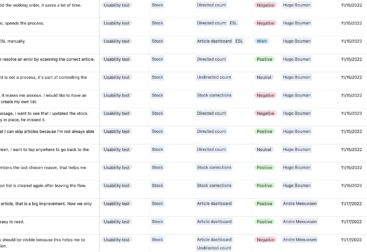Effective collaboration between UX designers and developers is crucial to create high-quality digital products that meet user needs and business objectives. However, in many organizations, designers and developers often work in silos, which can lead to communication gaps, conflicting goals, and inefficiencies. To address this challenge, we organized a workshop to bring UX designers and developers together and foster collaboration.
The whole company was invited, so we had a great mix of management, developers, designers, QA’ers, business analysts and product owners.
Introduction
We started the workshop by introducing ourselves and explaining the program. We emphasized the importance of collaboration between designers and developers and set the expectations for the workshop. We then divided the participants into teams of maximum four people.
Problem statement
To kick off the workshop, I presented the problem statement: development and UX always start at the same point and time when a project starts. However, the heavy point for development is in the back-end part, while for the front-end, there is nothing yet to start with. On the other hand, UX starts with problem research and solution research, which blocks the front-end development. This can result in delays and misaligned goals.
Create teams and work on “How might we…” questions
First step was to create teams. To address the problem, I asked each team to come up with “How might we…” (HMW) questions that would help them identify solutions. I encouraged the teams to focus on the main challenge and avoid diving straight into the solutions. After all the teams created their questions, we sorted the HMW stickies into different categories and had the group choose one to work on.
Sketching towards a solution
Each team then had 30 minutes to brainstorm innovative solutions to the chosen HMW question. We emphasized that the solutions should be detailed but not necessarily fancy and that the main goal was to make them presentable. We provided some tips for sketching, such as establishing a meaningful visual hierarchy and adding annotations with real text.
During the brainstorming phase, we encouraged the teams to consider how they could solve the main challenge they were working on, what the main goal of the solution was, what the main user actions were, and what the main messages might be.
Presenting the solution
After the brainstorming phase, each team presented their solution to the rest of the group. We used dot voting to allow each participant to vote for the best solution, using five dots. This helped us identify the most popular and effective solutions and ensured that everyone had a chance to contribute to the decision-making process.
Conclusion
The workshop was a success, with participants reporting that they gained a better understanding of the challenges and opportunities in collaborating with UX designers and developers. By working together and sharing their perspectives and expertise, the teams were able to come up with innovative solutions that addressed the main challenge. This workshop helped to establish a foundation for ongoing collaboration and communication between UX designers and developers in the organization.

